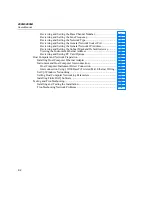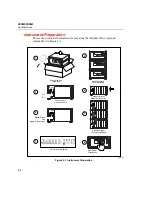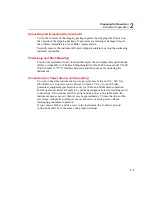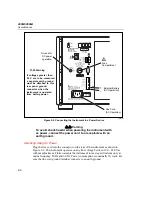
Overview
Instrument Features and Capabilities
1
1-9
Master Alarm
Master Alarm is an instrument output line that is logic low (n0.8 V dc) for
as long as any channel is in alarm while scanning is active. The connection uses
the ALARM/TRIGGER I/O terminals Master Alarm and GND (Figure 1-4). This
TTL output interfaces with external equipment such as warning lights, alarms,
automatic shutdowns, and paging systems. When the alarm condition ends or
scanning stops, an internal pull-up resistor sets the output at logic high (nominal
+5.0 V dc).
Interval Trigger
Interval Trigger is an internal software timer you can set using Fluke DAQ
software. It permits scanning at regular time intervals using Interval 1. Interval 1 is
in seconds, with a minimum of 0.000 (continuous scanning) and a maximum of
86400.000 (one scan every 24 hours). The time resolution is to the millisecond, for
example, 12.345 seconds.
External Trigger
External Trigger is started by an external event and triggers scanning when an
external logic low is applied to the instrument Trigger In line. As long as the
Trigger Input remains low, scans are triggered at regular time intervals using
Interval 2. Interval 2 is in seconds, with a minimum of 0.000 (continuous
scanning) and a maximum of 86400.000 (one scan every 24 hours). The time
resolution is to the millisecond, for example, 12.345 seconds. When scanning
starts, if the External Trigger is logic low, scanning begins at the Interval 2 rate. If
the External Trigger is logic high, no scans are triggered until the trigger line is set
to logic low.
If one or more external trigger events occur while a scan is in progress, one
triggered scan follows the scan in progress.
Alarms
Two alarms, Alarm 1 and Alarm 2, can be applied to any configured channel. An
alarm condition occurs when a measurement falls below a low alarm value, rises
above a high alarm value, or is between the two alarm values. If you apply Mx+B
scaling as part of the channel configuration, the instrument bases the alarms on the
scaled values.
When any configured channel is in alarm, the Alarm annunciator is on dim, or
bright if a channel in alarm is being used as an Alarm Trigger. When a channel is
in alarm, the rear-panel Master Alarm output is asserted (logic low). You can use
alarms to trigger scanning (see Alarm Trigger later in this chapter) and to set a
Digital I/O line to a logic low (see Digital I/O Module later in this chapter) or
close a relay. The Fluke DAQ software displays and records alarm conditions.
Summary of Contents for 2680A
Page 8: ......
Page 14: ...2680A 2686A Users Manual vi ...
Page 20: ...2680A 2686A Users Manual 1 2 ...
Page 98: ...2680A 2686A Users Manual 2 62 ...
Page 196: ......
Page 228: ...2680A 2686A Users Manual A 32 ...
Page 236: ...2680A 2686A Users Manual C 4 ...
Page 242: ...2680A 2686A Users Manual D 6 ...
Page 274: ...2680A 2686A Users Manual 6 ...
















































